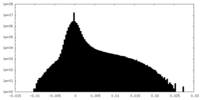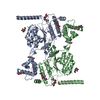[English] 日本語
 Yorodumi
Yorodumi- EMDB-44511: Structure of human GlcNAc-1-phosphotransferase complexed with the... -
+ Open data
Open data
- Basic information
Basic information
| Entry | 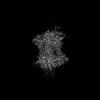 | |||||||||
|---|---|---|---|---|---|---|---|---|---|---|
| Title | Structure of human GlcNAc-1-phosphotransferase complexed with the donor substrate UDP-GlcNAc | |||||||||
 Map data Map data | ||||||||||
 Sample Sample |
| |||||||||
 Keywords Keywords | GlcNAc-1-phosphotransferase / lysosomal hydrolases / mannose 6-phosphate trafficking pathway / TRANSFERASE | |||||||||
| Function / homology |  Function and homology information Function and homology informationUDP-N-acetylglucosamine-lysosomal-enzyme N-acetylglucosaminephosphotransferase / N-glycan processing to lysosome / UDP-N-acetylglucosamine-lysosomal-enzyme N-acetylglucosaminephosphotransferase activity / secretion of lysosomal enzymes / carbohydrate phosphorylation / lysosome organization / Golgi membrane / calcium ion binding / Golgi apparatus Similarity search - Function | |||||||||
| Biological species |  Homo sapiens (human) Homo sapiens (human) | |||||||||
| Method | single particle reconstruction / cryo EM / Resolution: 2.9 Å | |||||||||
 Authors Authors | Li H | |||||||||
| Funding support |  United States, 1 items United States, 1 items
| |||||||||
 Citation Citation |  Journal: J Biol Chem / Year: 2024 Journal: J Biol Chem / Year: 2024Title: Structure of a truncated human GlcNAc-1-phosphotransferase variant reveals the basis for its hyperactivity. Authors: Hua Li / Balraj Doray / Benjamin C Jennings / Wang-Sik Lee / Lin Liu / Stuart Kornfeld / Huilin Li /  Abstract: Mutations that cause loss of function of GlcNAc-1-phosphotransferase (PTase) lead to the lysosomal storage disorder mucolipidosis II. PTase is the key enzyme of the mannose 6-phosphate (M6P) ...Mutations that cause loss of function of GlcNAc-1-phosphotransferase (PTase) lead to the lysosomal storage disorder mucolipidosis II. PTase is the key enzyme of the mannose 6-phosphate (M6P) targeting system that is responsible for tagging lysosomal hydrolases with the M6P moiety for their delivery to the lysosome. We had previously generated a truncated hyperactive form of PTase termed S1S3 which was shown to notably increase the phosphorylation level of secreted lysosomal enzymes and enhance their uptake by cells. Here, we report the 3.4 Å cryo-EM structure of soluble S1S3 lacking both transmembrane domains and cytosolic tails. The structure reveals a high degree of conservation of the catalytic core to full-length PTase. In this dimeric structure, the EF-hand of one protomer is observed interacting with the conserved region four of the other. In addition, we present a high-quality EM 3D map of the UDP-GlcNAc bound form of the full-length soluble protein showing the key molecular interactions between the nucleotide sugar donor and side chain amino acids of the protein. Finally, although the domain organization of S1S3 is very similar to that of the Drosophila melanogaster (fruit fly) PTase homolog, we establish that the latter does not act on lysosomal hydrolases. | |||||||||
| History |
|
- Structure visualization
Structure visualization
| Supplemental images |
|---|
- Downloads & links
Downloads & links
-EMDB archive
| Map data |  emd_44511.map.gz emd_44511.map.gz | 11.1 MB |  EMDB map data format EMDB map data format | |
|---|---|---|---|---|
| Header (meta data) |  emd-44511-v30.xml emd-44511-v30.xml emd-44511.xml emd-44511.xml | 21 KB 21 KB | Display Display |  EMDB header EMDB header |
| FSC (resolution estimation) |  emd_44511_fsc.xml emd_44511_fsc.xml | 11.4 KB | Display |  FSC data file FSC data file |
| Images |  emd_44511.png emd_44511.png | 138.9 KB | ||
| Masks |  emd_44511_msk_1.map emd_44511_msk_1.map | 125 MB |  Mask map Mask map | |
| Filedesc metadata |  emd-44511.cif.gz emd-44511.cif.gz | 7.3 KB | ||
| Others |  emd_44511_half_map_1.map.gz emd_44511_half_map_1.map.gz emd_44511_half_map_2.map.gz emd_44511_half_map_2.map.gz | 98.4 MB 98.4 MB | ||
| Archive directory |  http://ftp.pdbj.org/pub/emdb/structures/EMD-44511 http://ftp.pdbj.org/pub/emdb/structures/EMD-44511 ftp://ftp.pdbj.org/pub/emdb/structures/EMD-44511 ftp://ftp.pdbj.org/pub/emdb/structures/EMD-44511 | HTTPS FTP |
-Validation report
| Summary document |  emd_44511_validation.pdf.gz emd_44511_validation.pdf.gz | 725.1 KB | Display |  EMDB validaton report EMDB validaton report |
|---|---|---|---|---|
| Full document |  emd_44511_full_validation.pdf.gz emd_44511_full_validation.pdf.gz | 724.7 KB | Display | |
| Data in XML |  emd_44511_validation.xml.gz emd_44511_validation.xml.gz | 18.6 KB | Display | |
| Data in CIF |  emd_44511_validation.cif.gz emd_44511_validation.cif.gz | 24.5 KB | Display | |
| Arichive directory |  https://ftp.pdbj.org/pub/emdb/validation_reports/EMD-44511 https://ftp.pdbj.org/pub/emdb/validation_reports/EMD-44511 ftp://ftp.pdbj.org/pub/emdb/validation_reports/EMD-44511 ftp://ftp.pdbj.org/pub/emdb/validation_reports/EMD-44511 | HTTPS FTP |
-Related structure data
| Related structure data | 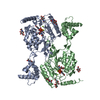 9bgfMC 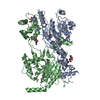 9bggC M: atomic model generated by this map C: citing same article ( |
|---|---|
| Similar structure data | Similarity search - Function & homology  F&H Search F&H Search |
- Links
Links
| EMDB pages |  EMDB (EBI/PDBe) / EMDB (EBI/PDBe) /  EMDataResource EMDataResource |
|---|---|
| Related items in Molecule of the Month |
- Map
Map
| File |  Download / File: emd_44511.map.gz / Format: CCP4 / Size: 125 MB / Type: IMAGE STORED AS FLOATING POINT NUMBER (4 BYTES) Download / File: emd_44511.map.gz / Format: CCP4 / Size: 125 MB / Type: IMAGE STORED AS FLOATING POINT NUMBER (4 BYTES) | ||||||||||||||||||||||||||||||||||||
|---|---|---|---|---|---|---|---|---|---|---|---|---|---|---|---|---|---|---|---|---|---|---|---|---|---|---|---|---|---|---|---|---|---|---|---|---|---|
| Projections & slices | Image control
Images are generated by Spider. | ||||||||||||||||||||||||||||||||||||
| Voxel size | X=Y=Z: 0.828 Å | ||||||||||||||||||||||||||||||||||||
| Density |
| ||||||||||||||||||||||||||||||||||||
| Symmetry | Space group: 1 | ||||||||||||||||||||||||||||||||||||
| Details | EMDB XML:
|
-Supplemental data
-Mask #1
| File |  emd_44511_msk_1.map emd_44511_msk_1.map | ||||||||||||
|---|---|---|---|---|---|---|---|---|---|---|---|---|---|
| Projections & Slices |
| ||||||||||||
| Density Histograms |
-Half map: #2
| File | emd_44511_half_map_1.map | ||||||||||||
|---|---|---|---|---|---|---|---|---|---|---|---|---|---|
| Projections & Slices |
| ||||||||||||
| Density Histograms |
-Half map: #1
| File | emd_44511_half_map_2.map | ||||||||||||
|---|---|---|---|---|---|---|---|---|---|---|---|---|---|
| Projections & Slices |
| ||||||||||||
| Density Histograms |
- Sample components
Sample components
-Entire : GlcNAc-1-phosphotransferase
| Entire | Name: GlcNAc-1-phosphotransferase |
|---|---|
| Components |
|
-Supramolecule #1: GlcNAc-1-phosphotransferase
| Supramolecule | Name: GlcNAc-1-phosphotransferase / type: complex / ID: 1 / Parent: 0 / Macromolecule list: #1 |
|---|---|
| Source (natural) | Organism:  Homo sapiens (human) Homo sapiens (human) |
| Molecular weight | Theoretical: 268 KDa |
-Macromolecule #1: N-acetylglucosamine-1-phosphotransferase subunits alpha/beta
| Macromolecule | Name: N-acetylglucosamine-1-phosphotransferase subunits alpha/beta type: protein_or_peptide / ID: 1 / Number of copies: 2 / Enantiomer: LEVO EC number: UDP-N-acetylglucosamine-lysosomal-enzyme N-acetylglucosaminephosphotransferase |
|---|---|
| Source (natural) | Organism:  Homo sapiens (human) Homo sapiens (human) |
| Molecular weight | Theoretical: 134.7875 KDa |
| Recombinant expression | Organism:  |
| Sequence | String: DEDQVDPRLI DGKWSRDQYH VLFDSYRDNI AGKSFQNRLC LPMPIDVVYT WVNGTDLELL KELQQVREQM EEEQKAMREI LGKNTTEPT KKSEKQLECL LTHCIKVPML VLDPALPANI TLKDLPSLYP SFHSASDIFN VAKPKNPSTN VSVVVFDSTK D VEDAHSGL ...String: DEDQVDPRLI DGKWSRDQYH VLFDSYRDNI AGKSFQNRLC LPMPIDVVYT WVNGTDLELL KELQQVREQM EEEQKAMREI LGKNTTEPT KKSEKQLECL LTHCIKVPML VLDPALPANI TLKDLPSLYP SFHSASDIFN VAKPKNPSTN VSVVVFDSTK D VEDAHSGL LKGNSRQTVW RGYLTTDKEV PGLVLMQDLA FLSGFPPTFK ETNQLKTKLP ENLSSKVKLL QLYSEASVAL LK LNNPKDF QELNKQTKKN MTIDGKELTI SPAYLLWDLS AISQSKQDED ISASRFEDNE ELRYSLRSIE RHAPWVRNIF IVT NGQIPS WLNLDNPRVT IVTHQDVFRN LSHLPTFSSP AIESHIHRIE GLSQKFIYLN DDVMFGKDVW PDDFYSHSKG QKVY LTWPV PNCAEGCPGS WIKDGYCDKA CNNSACDWDG GDCSGNSGGS RYIAGGGGTG SIGVGQPWQF GGGINSVSYC NQGCA NSWL ADKFCDQACN VLSCGFDAGD CGQDHFHELY KVILLPNQTH YIIPKGECLP YFSFAEVAKR GVEGAYSDNP IIRHAS IAN KWKTIHLIMH SGMNATTIHF NLTFQNTNDE EFKMQITVEV DTREGPKLNS TAQKGYENLV SPITLLPEAE ILFEDIP KE KRFPKFKRHD VNSTRRAQEE VKIPLVNISL LPKDAQLSLN TLDLQLEHGD ITLKGYNLSK SALLRSFLMN SQHAKIKN Q AIITDETNDS LVAPQEKQVH KSILPNSLGV SERLQRLTFP AVSVKVNGHD QGQNPPLDLE TTARFRVETH TQKTIGGNV TKEKPPSLIV PLESQMTKEK KITGKEKENS RMEENAENHI GVTEVLLGRK LQHYTDSYLG FLPWEKKKYF QDLLDEEESL KTQLAYFTD SKNRARYKRD TFADSLRYVN KILNSKFGFT SRKVPAHMPH MIDRIVMQEL QDMFPEEFDK TSFHKVRHSE D MQFAFSYF YYLMSAVQPL NISQVFDEVD TDQSGVLSDR EIRTLATRIH ELPLSLQDLT GLEHMLINCS KMLPADITQL NN IPPTQES YYDPNLPPVT KSLVTNCKPV TDKIHKAYKD KNKYRFEIMG EEEIAFKMIR TNVSHVVGQL DDIRKNPRKF VCL NDNIDH NHKDAQTVKA VLRDFYESMF PIPSQFELPR EYRNRFLHMH ELQEWRAYRD KLK UniProtKB: N-acetylglucosamine-1-phosphotransferase subunits alpha/beta |
-Macromolecule #3: CALCIUM ION
| Macromolecule | Name: CALCIUM ION / type: ligand / ID: 3 / Number of copies: 2 / Formula: CA |
|---|---|
| Molecular weight | Theoretical: 40.078 Da |
-Macromolecule #4: MAGNESIUM ION
| Macromolecule | Name: MAGNESIUM ION / type: ligand / ID: 4 / Number of copies: 4 / Formula: MG |
|---|---|
| Molecular weight | Theoretical: 24.305 Da |
-Macromolecule #5: URIDINE-DIPHOSPHATE-N-ACETYLGLUCOSAMINE
| Macromolecule | Name: URIDINE-DIPHOSPHATE-N-ACETYLGLUCOSAMINE / type: ligand / ID: 5 / Number of copies: 2 / Formula: UD1 |
|---|---|
| Molecular weight | Theoretical: 607.354 Da |
| Chemical component information |  ChemComp-UD1: |
-Macromolecule #6: 2-acetamido-2-deoxy-beta-D-glucopyranose
| Macromolecule | Name: 2-acetamido-2-deoxy-beta-D-glucopyranose / type: ligand / ID: 6 / Number of copies: 6 / Formula: NAG |
|---|---|
| Molecular weight | Theoretical: 221.208 Da |
| Chemical component information | 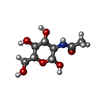 ChemComp-NAG: |
-Experimental details
-Structure determination
| Method | cryo EM |
|---|---|
 Processing Processing | single particle reconstruction |
| Aggregation state | particle |
- Sample preparation
Sample preparation
| Concentration | 0.15 mg/mL | ||||||||||||
|---|---|---|---|---|---|---|---|---|---|---|---|---|---|
| Buffer | pH: 7.8 Component:
| ||||||||||||
| Grid | Model: Quantifoil R2/1 / Material: COPPER / Mesh: 300 / Support film - Material: CARBON / Support film - topology: HOLEY | ||||||||||||
| Vitrification | Cryogen name: ETHANE / Chamber humidity: 95 % / Chamber temperature: 299 K / Instrument: FEI VITROBOT MARK IV |
- Electron microscopy
Electron microscopy
| Microscope | FEI TITAN KRIOS |
|---|---|
| Temperature | Min: 193.0 K / Max: 193.0 K |
| Alignment procedure | Coma free - Residual tilt: 0.05 mrad |
| Image recording | Film or detector model: GATAN K3 (6k x 4k) / Digitization - Dimensions - Width: 5760 pixel / Digitization - Dimensions - Height: 4092 pixel / Number grids imaged: 1 / Number real images: 24130 / Average exposure time: 1.0 sec. / Average electron dose: 60.0 e/Å2 |
| Electron beam | Acceleration voltage: 300 kV / Electron source:  FIELD EMISSION GUN FIELD EMISSION GUN |
| Electron optics | C2 aperture diameter: 70.0 µm / Illumination mode: OTHER / Imaging mode: BRIGHT FIELD / Cs: 2.7 mm / Nominal defocus max: 1.6 µm / Nominal defocus min: 1.0 µm / Nominal magnification: 105000 |
| Sample stage | Specimen holder model: FEI TITAN KRIOS AUTOGRID HOLDER / Cooling holder cryogen: NITROGEN |
| Experimental equipment |  Model: Titan Krios / Image courtesy: FEI Company |
 Movie
Movie Controller
Controller




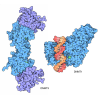
 Z (Sec.)
Z (Sec.) Y (Row.)
Y (Row.) X (Col.)
X (Col.)



































